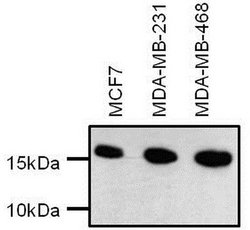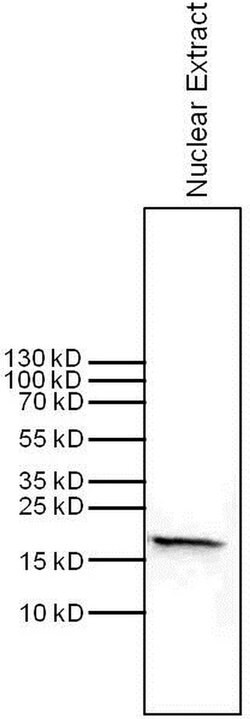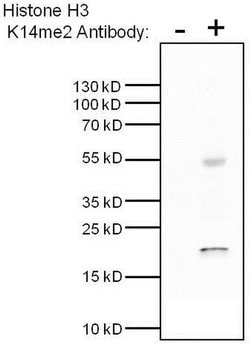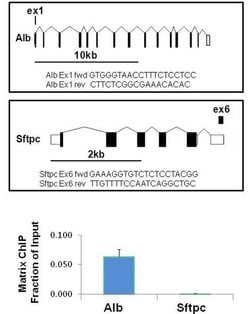Learn More
Invitrogen™ H3K14me2 Monoclonal Antibody (5HH3-2B10)
Mouse Monoclonal Antibody
Supplier: Invitrogen™ MA3059
Description
MA3-059 detects histone H3 in human samples and has successfully been used in western blot, immunoprecipitation and immunofluorescence applications. The MA3-059 immunogen is a synthetic peptide conjugated to ovalbumin corresponding to residues 6-17 of Human Histone H3, which is highly conserved across multiple species.
Histone H3 is one of the DNA-binding proteins found in the chromatin of all eukaryotic cells. H3 along with four core histone proteins binds to DNA forming the structure of the nucleosome. Histones play a central role in transcription regulation, DNA repair, DNA replication and chromosomal stability. Post translationally, histones are modified in a variety of ways to either directly change the chromatin structure or allow for the binding of specific transcription factors. The N-terminal tail of histone H3 protrudes from the globular nucleosome core and can undergo several different types of post-translational modification that influence cellular processes. These modifications include the covalent attachment of methyl or acetyl groups to lysine and arginine amino acids and the phosphorylation of serine or threonine.
Specifications
| H3K14me2 | |
| Monoclonal | |
| Conc. Not Determined | |
| Ascites with 0.05% sodium azide | |
| P68431, Q71DI3 | |
| H3C1, H3C10, H3C12, H3C14, H3C15, H3C2, H3C7 | |
| Ovalbumin conjugated synthetic peptide (TARKSTGG[dimethyl-K]APRC) correspeonding to aa 6-17 of histone H3. | |
| RUO | |
| 126961, 333932, 8350, 8356, 8357, 8358, 8968 | |
| -20°C, Avoid Freeze/Thaw Cycles | |
| Liquid |
| ChIP Assay, Immunoprecipitation, Western Blot, Immunocytochemistry | |
| 5HH3-2B10 | |
| Unconjugated | |
| H3C15 | |
| dimethyl H3; di-methyl H3; dimethyl histone H3; di-methyl histone H3; Di-Methyl-H3 K14; Di-Methyl-H3 Lys14; Di-Methyl-Histone H3 K14; Di-Methyl-Histone H3 Lys14; H3; H3 histone; H3 histone family, member A; H3 histone family, member I; H3 histone family, member K; H3 histone family, member L; H3 histone family, member M; H3 histone, family 2; H3 histone, family 3A; H3 histone, family 3B; H3 histone, family 3B (H3.3B); H3 histone, family 3C; H3 K14me2; H3.1-221; H3.1-291; H3.1-I; H3.2; H3.2-221; H3.2-614; H3.2-615; H3.2-616; H3.3A; H3.3B; H3.5; H3/A; H3/b; H3/d; H3/f; H3/i; H3/j; H3/k; H3/l; H3/M; H3/n; H3/o; H3-143; H3-291; H3-3A; H3-3B; H3-53; H3-614; H3a; H3b; H3-B; H3c1; H3C10; H3c11; H3C12; H3C2; H3C3; H3C4; H3C6; H3C7; H3C8; H3f; H3-F; H3F1K; H3F2; H3F3; H3F3A; H3f3b; H3F3C; H3FA; H3FB; H3FC HIST1H3C; H3FD; H3FF; H3FH; H3FI; H3FJ; H3FK; H3FL; H3FM; H3FN; H3g; H3h; H3i; H3K14; H3Lys14me2; Hist1; HIST1H3A; Hist1h3b; Hist1h3c; HIST1H3D; HIST1H3E; HIST1H3F; Hist1h3g; Hist1h3h; Hist1h3i; HIST1H3J; HIST2H3A; Hist2h3b; HIST2H3C; Hist2h3c1; Hist2h3c2; Hist2h3c2-ps; Hist2h3ca1; Hist2h3ca2; HIST2H3D; histone 1, H3a; histone 1, H3b; histone 1, H3f; histone 1, H3h; histone 2, H3a; histone 2, H3c; histone 2, H3c2; histone 2, H3ca2; Histone 3; histone cluster 1, H3a; histone cluster 1, H3b; histone cluster 1, H3f; histone cluster 1, H3h; histone cluster 2, H3a; histone cluster 2, H3c; histone cluster 2, H3c2; histone cluster 2, H3c2, pseudogene; histone gene complex 1; histone H3; histone H3.1; Histone H3.2; histone H3.3; Histone H3.3C; histone H3.5; Histone H3/a; Histone H3/b; Histone H3/c; Histone H3/d; Histone H3/f; Histone H3/h; Histone H3/i; Histone H3/j; Histone H3/k; histone H3/l; Histone H3/m; histone H3/o; Histone H3K14; Histone H3K14me2; histone variant H3.5; M32461; methyl Histone 3; methyl Histone H3; PP781 | |
| Mouse | |
| 50 μL | |
| Primary | |
| Human | |
| Antibody | |
| IgG1 |
Your input is important to us. Please complete this form to provide feedback related to the content on this product.





